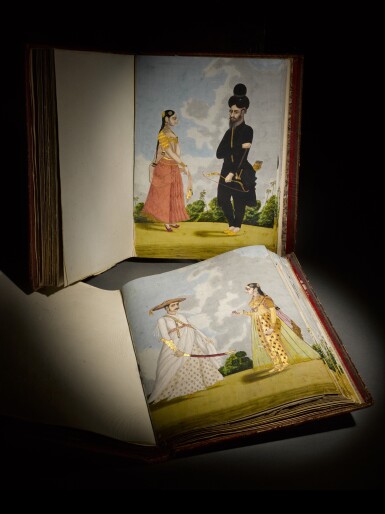
Property of a Gentleman
Costumes of India: an album of occupations, South India, probably Madras, Company School, late 18th century
Estimate
50,000 - 80,000 GBP
Lot Details
Description
in two volumes, opaque pigments on paper, 52 full page paintings divided over two volumes, with four flyleaves, each painting mounted on cardboard and bound before 1906, with three loose folios containing descriptions of the subjects of the paintings, in red leather binding with gilt details, front boards with bookplate of Maj.-Gen. Henry George White (1835-1906)
(2)
paintings: 32.3 by 23cm.
Charles Nicholas White (1754-1839) and Letitia White
The albums passed through the descendants of the family as follows: Rev Henry White (1804-85); Major General Henry George White, Lough Eske Castle, Co. Donegal, Ireland (1835-1906); Major Henry Herbert Ronald White D.S.O, O.B.E., (1879-1939); Colonel John Maxwell White (1909-88)
This remarkable set of albums, containing fifty-two paintings, has remained in the same family since it was commissioned at least 225 years ago by Charles White, Chief Secretary to the Government of Madras and Judge of the High Court, and his wife Letitia.
Charles Nicholas White was born in Alphington Hall, Devon, on 18 June 1754. At the age of 21, he was appointed as a writer on the Madras Establishment. During the eighteenth century, such an appointment was by patronage and generally reserved for members of the upper class (Bowen 1955, p.8). Initially employed as a copying clerk, he would have been instructed in Persian and the local language before working up the ranks of the East India Company. White's great aptitude as a writer lead to appointment as a secretary to government by 1780, promotion to civil secretaryship in the office of the Clerk of Appeals in 1785, and finally membership of the prestigious Madras Board of Revenue in 1792 (IOR/O/6/12, pp.179-185). In the same year, he married his wife Letitia Mytton Williams at Fort George. Eight years later, he resigned his position as a senior member of the Board and returned to England, where he lived until 20 February 1839.
An acquaintance of famous botanist William Roxburgh, whose commission of botanical paintings form one of the pinnacles of Company School painting, Charles White, or his wife, showed a deeper interest in the inhabitants of Madras and surroundings. This intriguing two-volume album of paintings contains a wide range of double portraits, almost always husband and wife, which emphasise the beautiful and often very luxurious clothing of the sitters. Although none of the paintings are signed and no information about the artists or the conditions of the commission are recorded, the subtle, refined brushwork that characterises the best Company School paintings is present in abundance.
An album of thirty-six paintings of castes and occupations is in the Victoria & Albert Museum, London (AL.9128:2). The paintings, attributed to Tanjore, circa 1770, are executed in a comparable style, although lack the atmosphere and detail rendered in the clouds and background of those in the present two albums.
You May Also Like

![An extremely rare illustrated manuscript of the Ka'banameh (A history of the Ka'ba) by Abdulrahman Gubari (d.1566), signed by Ahmad [...] al-Khatib, Kaposvár, Hungary, dated Dhu'l-Hijjah 1080 AH/April-May 1670 AD](https://dam.sothebys.com/dam/image/lot/1e33ac28-a449-4673-a23f-f1ca4d5a13b3/primary/extra_small)








